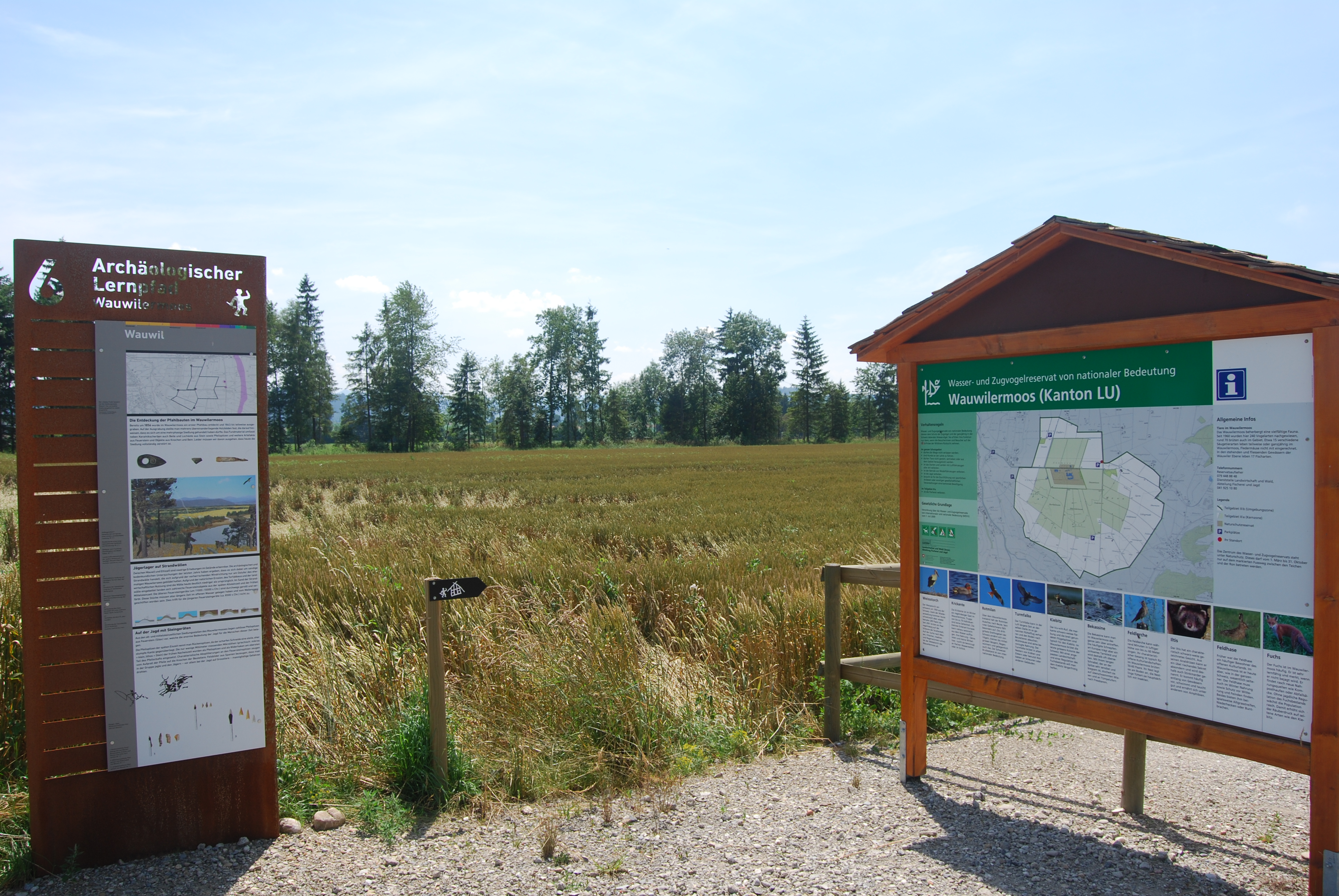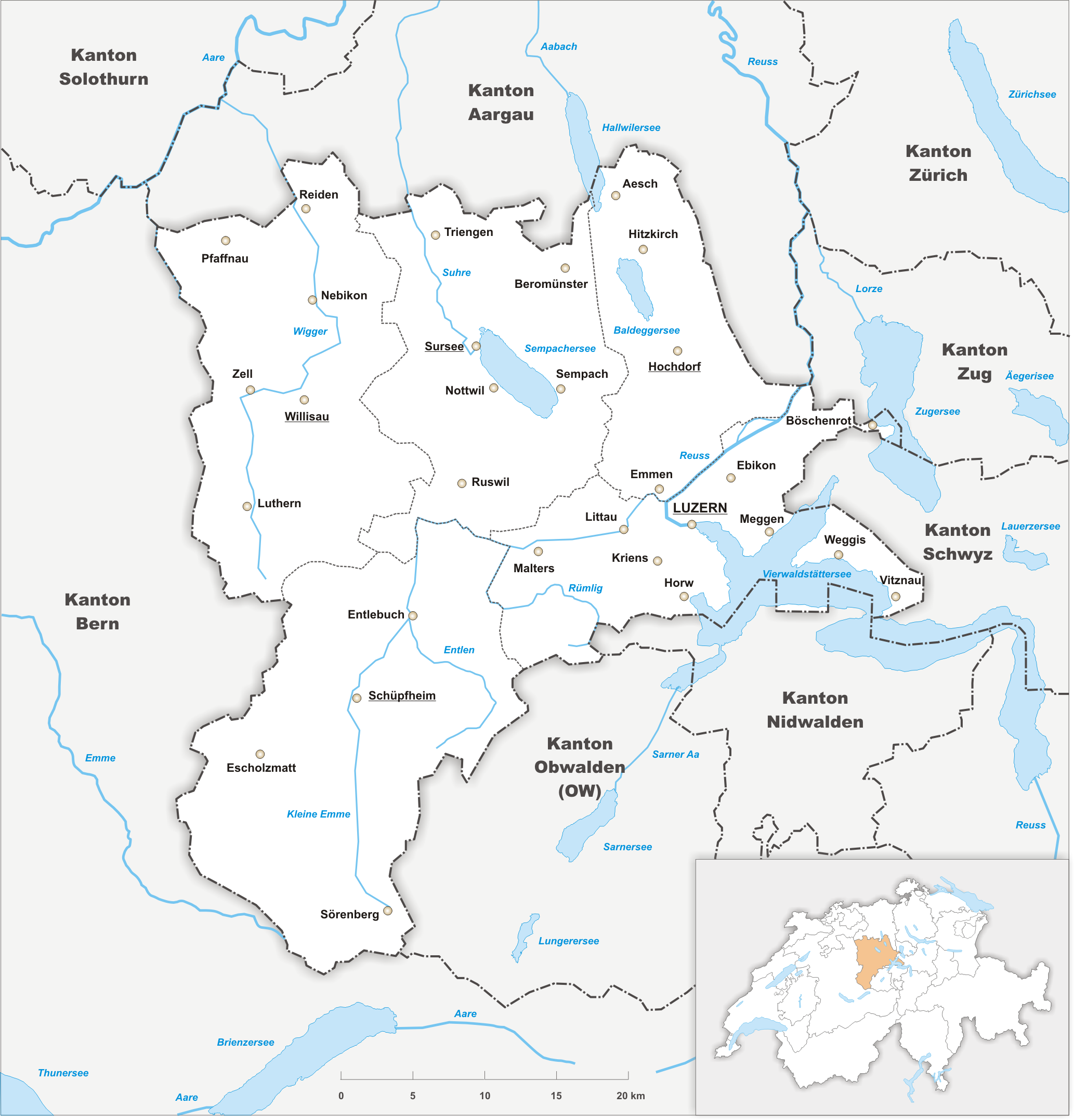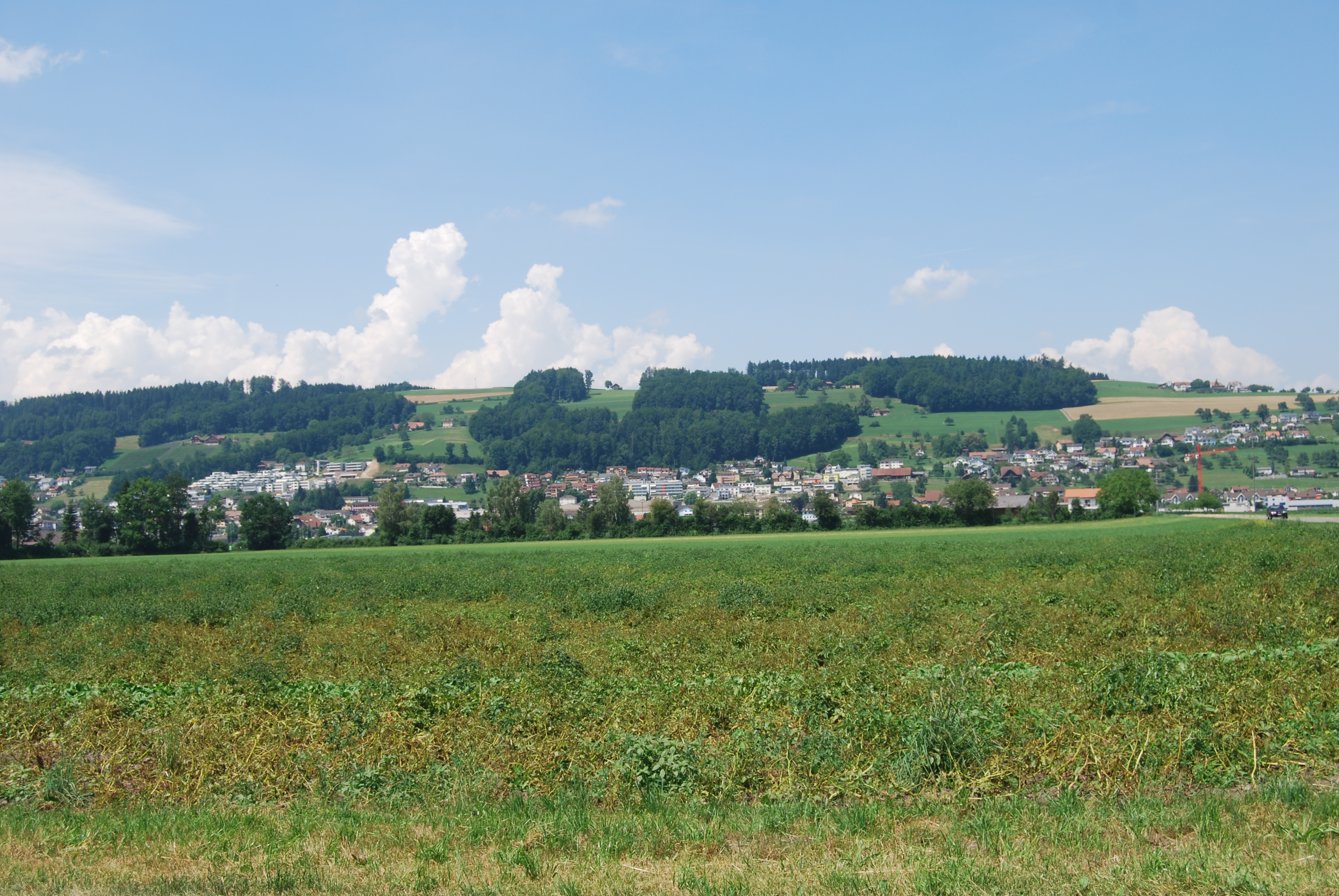|
Egolzwil
Egolzwil is a municipality in the district of Willisau in the canton of Lucerne in Switzerland. History Egolzwil is first mentioned around 1160 as ''Eigoltiswile''. During World War II, Allied soldiers who were caught after their escape from the Swiss internment camps were detained in the prison camp Wauwilermoos. Geography Egolzwil has an area, , of . Of this area, 61.9% is used for agricultural purposes, while 24% is forested. Of the rest of the land, 12.9% is settled (buildings or roads) and the remainder (1.2%) is non-productive (rivers, glaciers or mountains). , 23.74% of the total land area was forested. Of the agricultural land, 58.51% is used for farming or pastures, while 3.6% is used for orchards or vine crops. Of the settled areas, 6.95% is covered with buildings, 1.2% is industrial, 0.24% is classed as special developments, 0.24% is parks or greenbelts and 4.32% is transportation infrastructure. Of the unproductive areas, 0.72% is unproductive standing water (p ... [...More Info...] [...Related Items...] OR: [Wikipedia] [Google] [Baidu] |
Egolzwil 3
Wauwilermoos or Egolzwil 3 is one of the 111 serial sites of the UNESCO World Heritage Site ''Prehistoric pile dwellings around the Alps'', of which are 56 located in Switzerland. Geography The site is located on the former Wauwilersee lakeshore in the municipalities of Egolzwil, Wauwil and Schötz in the Canton of Luzern in Switzerland. The settlement comprises , and the buffer zone including the lake area comprises in all. Around 20000 BC a branch of the Reuss glacier formed a valley whose deepest point was approximately below the present surface. At Schötz the glacier stopped, as shown by the impressive moraines. During the retreat of the glacier, meltwater jammed between the moraines. Thus in the Wauwilermoos plain three lakes were formed: ''Wauwilersee'', ''Hagimoos'' and ''Mauensee''; latter still exists. The meltwater outsourced enormous amounts of sand, so that the lakes never were particularly deep. The depth of Wauwilersee amounted only to about . To 17000 BC the are ... [...More Info...] [...Related Items...] OR: [Wikipedia] [Google] [Baidu] |
Prehistoric Pile Dwellings Around The Alps
Prehistoric pile dwellings around the Alps are a series of prehistoric pile dwelling (or stilt house) settlements in and around the Alps built from about 5000 to 500 BC on the edges of lakes, rivers or wetlands. In 2011, 111 sites located variously in Switzerland (56), Italy (19), Germany (18), France (11), Austria (5) and Slovenia (2) were added to the UNESCO World Heritage Site list. In Slovenia, these were the first World Heritage Sites to be listed for their cultural value. Excavations conducted at some of the sites have yielded evidence regarding prehistoric life and the way communities interacted with their environment during the Neolithic and Bronze Ages in Alpine Europe. These settlements are a unique group of exceptionally well-preserved and culturally rich archaeological sites, which constitute one of the most important sources for the study of early agrarian societies in the region. Contrary to popular belief, the dwellings were not erected over water, but on nearby ma ... [...More Info...] [...Related Items...] OR: [Wikipedia] [Google] [Baidu] |
Wauwilermoos Internment Camp
Wauwilermoos was an internment camp and prisoner-of-war penal camp in Switzerland during World War II. It was situated in the municipalities of Wauwil and Egolzwil in the Canton of Lucerne (Luzern). Established in 1940, Wauwilermoos was a penal camp for internees, including Allied soldiers, among them members of the United States Army Air Forces, who were sentenced for attempting to escape from other Swiss camps for interned soldiers, or other offences. Together with Hünenberg and Les Diablerets, Wauwilermoos was one of three Swiss penal camps for internees that were established in Switzerland during World War II. The intolerable conditions were later described by numerous former inmates and by various contemporary reports and studies. History Established in 1940, Wauwilermoos was a penal camp for internees, particularly for Allied soldiers during World War II. Unlike civilians, for instance Jewish refugees, who were usually sent back to the territories occupied by the Nazi ... [...More Info...] [...Related Items...] OR: [Wikipedia] [Google] [Baidu] |
Lucerne (canton)
The canton of Lucerne (german: Kanton Luzern rm, Chantun Lucerna french: Canton de Lucerne it, Canton Lucerna) is a canton of Switzerland. It is located in the centre of Switzerland. The population of the canton (as of ) is . , the population included 57,268 foreigners, or about 15.8% of the total population. The cantonal capital is Lucerne. History The canton of Lucerne comprises territories acquired by its capital Lucerne, either by treaty, armed occupation or purchase. The first town acquired was Weggis (in 1380), Rothenburg, Kriens, Horw, Sempach and Hochdorf (all in 1394), Wolhusen and Entlebuch (1405), the so-called "Habsburger region" to the northeast of the town of Lucerne (1406), Willisau (1407), Sursee and Beromünster (1415), Malters (1477) and Littau (1481), while in 1803, in exchange for Hitzkirch, Merenschwand (held since 1397) was given up. Prehistory The oldest traces of humans in the Lucerne area are stone artifacts and cave bear bones found in the St ... [...More Info...] [...Related Items...] OR: [Wikipedia] [Google] [Baidu] |
Wauwil
Wauwil is a municipality in the district of Willisau in the canton of Lucerne in Switzerland. Geography Wauwil has an area, , of . Of this area, 72.1% is used for agricultural purposes, while 9.9% is forested. The rest of the land, (18%) is settled. , 10.17% of the total land area was forested. Of the agricultural land, 69.15% is used for farming or pastures, while 2.71% is used for orchards or vine crops. Of the settled areas, 10.85% is covered with buildings, 2.37% is industrial, 0.34% is classed as special developments, 0.68% is parks or greenbelts and 3.73% is transportation infrastructure. History The prehistoric lakeside settlement Wauwilermoos is listed as a Swiss heritage site of national significance. Also known as Egolzwil 3, the serial site of 56 sites in Switzerland is also part of the UNESCO World Heritage Site ''Prehistoric Pile dwellings around the Alps''. During World War II, mainly Allied soldiers who were caught after their escape from the Swiss inter ... [...More Info...] [...Related Items...] OR: [Wikipedia] [Google] [Baidu] |
Dagmersellen
Dagmersellen is a municipality in the district of Willisau in the canton of Lucerne in Switzerland. On 1 January 2006, the former municipalities of Buchs and Uffikon were merged into Dagmersellen, causing a one-third increase in its population and a marked increase in its territorial area. accessed 25 August 2009 History Dagmersellen is first mentioned around 1070–1090 as ''Tagmarsellen''. In 1173 it was mentioned as ''Tagemarsseildon''.Geography Dagmersellen has an area, , of . Of this area, 54.5% is used for agricultural purposes, while 34% is forested. Of the rest of the land, 10.2% is settled (buildings or roads) and the remainder (1.3%) is non-productive (rivers, glaciers or mo ...[...More Info...] [...Related Items...] OR: [Wikipedia] [Google] [Baidu] |
Willisau (Amt)
Willisau District is one of the five districts (german: Ämter) of the German-speaking Canton of Lucerne, Switzerland. Its capital is the town of Willisau. It has a population of (as of ). In 2013 its name was changed from Amt Willisau to Wahlkreis Willisau as part of a reorganization of the canton. A sixth Wahlkreis was created, but in Willisau everything else remained essentially unchanged. Willisau District consists of the following municipalities: : 1992/97 survey gives a total area of without including certain large lakes, while the 2000 survey includes lakes but due to other changes is slightly lower. Mergers *On 1 January 2020 the former municipality of Ebersecken Ebersecken is a former municipality in the district of Willisau in the canton of Lucerne in Switzerland. On 1 January 2020 the former municipality of Ebersecken merged into Altishofen. History Ebersecken is first mentioned in 1274 as ''Ebersec ... merged into Altishofen. *On 1 January 2021 the former ... [...More Info...] [...Related Items...] OR: [Wikipedia] [Google] [Baidu] |
Willisau (district)
Willisau District is one of the five districts (german: Ämter) of the German-speaking Canton of Lucerne, Switzerland. Its capital is the town of Willisau. It has a population of (as of ). In 2013 its name was changed from Amt Willisau to Wahlkreis Willisau as part of a reorganization of the canton. A sixth Wahlkreis was created, but in Willisau everything else remained essentially unchanged. Willisau District consists of the following municipalities: : 1992/97 survey gives a total area of without including certain large lakes, while the 2000 survey includes lakes but due to other changes is slightly lower. Mergers *On 1 January 2020 the former municipality of Ebersecken merged into Altishofen. *On 1 January 2021 the former municipality of Gettnau Gettnau is a former municipality in the district of Willisau in the canton of Lucerne in Switzerland. On 1 January 2021 the former municipality of Gettnau merged into Willisau. History Gettnau is first mentioned in the 9th Cen ... [...More Info...] [...Related Items...] OR: [Wikipedia] [Google] [Baidu] |
Schötz
Schötz is a municipality in the district of Willisau in the canton of Lucerne in Switzerland. On 1 January 2013 the former municipality of Ohmstal merged into the municipality of Schötz.Nomenklaturen – Amtliches Gemeindeverzeichnis der Schweiz accessed 9 February 2013 Geography Schötz has an area, , of . Of this area, 69.3% is used for agricultural purposes, while 17.9% is forested. Of the rest of the land, 10.9% is settled (buildings or roads) and the remainder (1.9%) is non-productive (rivers, glaciers or mountains). , 17.87% of the total land area was forested. Of the agricultural land, 67.55% is used for farming or pastures, while 1.74% is used for orchards or vine crops. Of the settled a ...[...More Info...] [...Related Items...] OR: [Wikipedia] [Google] [Baidu] |
Nebikon
Nebikon is a municipality in the district of Willisau in the canton of Lucerne in Switzerland. History Nebikon is first mentioned in 924 as ''Nevinhova''. Geography Nebikon has an area, , of . Of this area, 38.3% is used for agricultural purposes, while 39.9% is forested. Of the rest of the land, 20.6% is settled (buildings or roads) and the remainder (1.1%) is non-productive rivers. , 40.05% of the total land area was forested. Of the agricultural land, 35.22% is used for farming or pastures, while 2.96% is used for orchards or vine crops. Of the settled areas, 9.95% is covered with buildings, 4.84% is industrial, 1.34% is parks or greenbelts and 4.57% is transportation infrastructure. The municipality is located at the confluence of the Luthern and Wigger rivers. Demographics Nebikon has a population (as of ) of . , 585 or about 25.7% are not Swiss citizens. [...More Info...] [...Related Items...] OR: [Wikipedia] [Google] [Baidu] |
UNESCO
The United Nations Educational, Scientific and Cultural Organization is a specialized agency of the United Nations (UN) aimed at promoting world peace and security through international cooperation in education, arts, sciences and culture. It has 193 member states and 12 associate members, as well as partners in the non-governmental, intergovernmental and private sector. Headquartered at the World Heritage Centre in Paris, France, UNESCO has 53 regional field offices and 199 national commissions that facilitate its global mandate. UNESCO was founded in 1945 as the successor to the League of Nations's International Committee on Intellectual Cooperation.English summary). Its constitution establishes the agency's goals, governing structure, and operating framework. UNESCO's founding mission, which was shaped by the Second World War, is to advance peace, sustainable development and human rights by facilitating collaboration and dialogue among nations. It pursues this objective t ... [...More Info...] [...Related Items...] OR: [Wikipedia] [Google] [Baidu] |
Fachhochschule
A ''Fachhochschule'' (; plural ''Fachhochschulen''), abbreviated FH, is a university of applied sciences (UAS), in other words a German tertiary education institution that provides professional education in many applied sciences and applied arts, such as engineering, technology, business, architecture, design, and industrial design. ''Fachhochschulen'' were first founded in Germany and were later adopted in Austria, Liechtenstein, Switzerland, Cyprus, and Greece. An increasing number of ''Fachhochschulen'' are abbreviated as ''Hochschule'', the generic term in Germany for institutions awarding academic degrees in higher education, or expanded as ''Hochschule für angewandte Wissenschaften (HAW)'', the German translation of "universities of applied sciences", which are primarily designed with a focus on teaching professional skills. Swiss law calls ''Fachhochschulen'' and universities "separate but equal". Due to the Bologna process, universities and ''Fachhochschulen'' award l ... [...More Info...] [...Related Items...] OR: [Wikipedia] [Google] [Baidu] |




